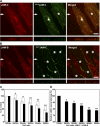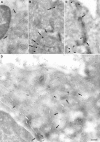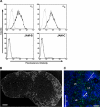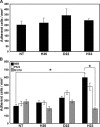Dual interaction of JAM-C with JAM-B and alpha(M)beta2 integrin: function in junctional complexes and leukocyte adhesion
- PMID: 16093349
- PMCID: PMC1237098
- DOI: 10.1091/mbc.e05-04-0310
Dual interaction of JAM-C with JAM-B and alpha(M)beta2 integrin: function in junctional complexes and leukocyte adhesion
Abstract
The junctional adhesion molecules (JAMs) have been recently described as interendothelial junctional molecules and as integrin ligands. Here we show that JAM-B and JAM-C undergo heterophilic interaction in cell-cell contacts and that JAM-C is recruited and stabilized in junctional complexes by JAM-B. In addition, soluble JAM-B dissociates soluble JAM-C homodimers to form JAM-B/JAM-C heterodimers. This suggests that the affinity of JAM-C monomers to form dimers is higher for JAM-B than for JAM-C. Using antibodies against JAM-C, the formation of JAM-B/JAM-C heterodimers can be abolished. This liberates JAM-C from its vascular binding partner JAM-B and makes it available on the apical side of vessels for interaction with its leukocyte counter-receptor alpha(M)beta2 integrin. We demonstrate that the modulation of JAM-C localization in junctional complexes is a new regulatory mechanism for alpha(M)beta2-dependent adhesion of leukocytes.
Figures










Similar articles
-
The junctional adhesion molecule 3 (JAM-3) on human platelets is a counterreceptor for the leukocyte integrin Mac-1.J Exp Med. 2002 Sep 2;196(5):679-91. doi: 10.1084/jem.20020267. J Exp Med. 2002. PMID: 12208882 Free PMC article.
-
The role of junctional adhesion molecule-C (JAM-C) in oxidized LDL-mediated leukocyte recruitment.FASEB J. 2005 Dec;19(14):2078-80. doi: 10.1096/fj.05-4196fje. Epub 2005 Sep 29. FASEB J. 2005. PMID: 16195363
-
Junctional adhesion molecule A expressed on human CD34+ cells promotes adhesion on vascular wall and differentiation into endothelial progenitor cells.Arterioscler Thromb Vasc Biol. 2010 Jun;30(6):1127-36. doi: 10.1161/ATVBAHA.110.204370. Epub 2010 Apr 8. Arterioscler Thromb Vasc Biol. 2010. PMID: 20378847
-
The JAM family of junctional adhesion molecules.Curr Opin Cell Biol. 2003 Oct;15(5):525-30. doi: 10.1016/s0955-0674(03)00104-2. Curr Opin Cell Biol. 2003. PMID: 14519386 Review.
-
Mechanisms of outside-in signaling at the tight junction by junctional adhesion molecule A.Ann N Y Acad Sci. 2009 May;1165:10-8. doi: 10.1111/j.1749-6632.2009.04034.x. Ann N Y Acad Sci. 2009. PMID: 19538282 Review.
Cited by
-
The Basic Requirement of Tight Junction Proteins in Blood-Brain Barrier Function and Their Role in Pathologies.Int J Mol Sci. 2024 May 21;25(11):5601. doi: 10.3390/ijms25115601. Int J Mol Sci. 2024. PMID: 38891789 Free PMC article. Review.
-
Relocalization of junctional adhesion molecule A during inflammatory stimulation of brain endothelial cells.Mol Cell Biol. 2012 Sep;32(17):3414-27. doi: 10.1128/MCB.06678-11. Epub 2012 Jun 25. Mol Cell Biol. 2012. PMID: 22733993 Free PMC article.
-
Junctional adhesion molecule 2 mediates the interaction between hatched blastocyst and luminal epithelium: induction by progesterone and LIF.PLoS One. 2012;7(4):e34325. doi: 10.1371/journal.pone.0034325. Epub 2012 Apr 12. PLoS One. 2012. PMID: 22511936 Free PMC article.
-
Junctional adhesion molecule (JAM)-B supports lymphocyte rolling and adhesion through interaction with alpha4beta1 integrin.Immunology. 2009 Oct;128(2):196-205. doi: 10.1111/j.1365-2567.2009.03100.x. Immunology. 2009. PMID: 19740376 Free PMC article.
-
A seamless trespass: germ cell migration across the seminiferous epithelium during spermatogenesis.J Cell Biol. 2007 Aug 13;178(4):549-56. doi: 10.1083/jcb.200704061. J Cell Biol. 2007. PMID: 17698604 Free PMC article. Review.
References
-
- Altamirano, M. M., Woolfson, A., Donda, A., Shamshiev, A., Briseno-Roa, L., Foster, N. W., Veprintsev, D. B., De Libero, G., Fersht, A. R., and Milstein, C. (2001). Ligand-independent assembly of recombinant human CD1 by using oxidative refolding chromatography. Proc. Natl. Acad. Sci. USA 98, 3288-3293. - PMC - PubMed
-
- Arrate, M. P., Rodriguez, J. M., Tran, T. M., Brock, T. A., and Cunningham, S. A. (2001). Cloning of human junctional adhesion molecule 3 (JAM3) and its identification as the JAM2 counter-receptor. J. Biol. Chem. 276, 45826-45832. - PubMed
-
- Aurrand-Lions, M., Duncan, L., Ballestrem, C., and Imhof, B. A. (2001a). JAM-2, a novel Ig superfamily molecule, expressed by endothelial and lymphatic cells. J. Biol. Chem. 276, 2733-2741. - PubMed
-
- Aurrand-Lions, M., Johnson-Leger, C., Wong, C., Du Pasquier, L., and Imhof, B. A. (2001b). Heterogeneity of endothelial junctions is reflected by differential expression and specific subcellular localization of the three JAM family members. Blood 98, 3699-3707. - PubMed
-
- Aurrand-Lions, M., Lamagna, C., Dangerfield, J. P., Wang, S., Herrera, P., Nourshargh, S., and Imhof, B. A. (2005). Junctional adhesion molecule-C regulates the early influx of leukocytes into tissues during inflammation. J. Immunol. 174, 6406-6415. - PubMed
Publication types
MeSH terms
Substances
Grants and funding
LinkOut - more resources
Full Text Sources
Other Literature Sources
Molecular Biology Databases

